Study of Surface Modifications of Textile Card Clothing (AISI 1065 Alloy) by Laser Shock Peening
Abstract
1. Introduction
2. Materials and Methods
2.1. Materials
2.2. Methods
3. Results and Discussions
3.1. Microstructural Analysis
3.2. Residual Stresses
3.3. Surface Roughness
3.4. Microhardness
4. Conclusions
- The microstructure of the laser-peened samples with and without sacrificial layers was analyzed and compared with that of the unpeened sample. LSP changes the microstructure of the base sample from martensite to a bainite phase that has finely dispersed carbides. The martensite phases increase the brittleness of the sample, which greatly affects the carding process. The bainite phase surface increases the hardness without sacrificing the toughness. The microstructure of both laser-peened samples with and without black paint has a bainite phase; this suggests that the tip of the doffer wire can be irradiated by laser pulses without black paint; doffer wire is used in large textile industries.
- The shock waves induced on the surface cause plastic deformations in the surface and subsurface areas that induce compressive residual stresses. These compressive residual stresses increase dislocation density, which blocks dislocation movement at the grain boundary, improving fatigue life by enhancing work hardening. An increase in residual stresses of about 194% occurred after LSP processes. The ablative layer increased the residual stresses by 6.3%.
- The Vickers hardness test shows that LSP increased the hardness of the sample by 11.2% when compared with the unpeened sample. The hardness value increased by 7 HV between the samples with and without a sacrificial layer, from 209 HV with a coating to 216 HV without a coating.
- The LSP process increased the surface roughness of the sample without coating by 44% and that of the sample with black paint by 14%, confirming the protective role played by the ablative layer in reducing laser ablation. LSP with a protective layer is a mechanical process, whereas without an ablative layer, the surface absorbs the thermal energy of the laser, so it is a thermo mechanical process. The increase in the surface roughness of the cutting edge adds an advantage to metallic card clothing; it increases the holding capacity of the fiber, which plays the same role as horizontal serrated doffers.
Author Contributions
Funding
Data Availability Statement
Acknowledgments
Conflicts of Interest
References
- Abdulkareem, S.; Busari, R.; Fashola, L.; Madu, I. Characteristics of Notched High Strength Materials Under Tension, Torsion and Impact Loading. Int. J. Eng. Mater. Manuf. 2020, 5, 68–75. [Google Scholar] [CrossRef]
- A Bagwan, A.S.; Jadhav, K. Card Setting: A Factor for Controlling Sliver Quality and Yarn. J. Text. Sci. Eng. 2016, 6, 246–260. [Google Scholar] [CrossRef]
- Montross, C.S.; Wei, T.; Ye, L.; Clark, G.; Mai, Y.-W. Laser shock processing and its effects on microstructure and properties of metal alloys: A review. Int. J. Fatigue 2002, 24, 1021–1036. [Google Scholar] [CrossRef]
- Kuo, C.-F.J.; Chou, Y.-C.; Lin, T.-Y. Automatic control of the roller carding machine part II: A study on the application of a sliding mode controller on the roller carding machine. Text. Res. J. 2012, 82, 1765–1773. [Google Scholar] [CrossRef]
- Kulkarni, A.; Chettri, S.; Prabhakaran, S.; Kalainathan, S. Effect of Laser Shock Peening (LSP) without Coating on the Surface Morphology and Mechanical Properties of Nickel Alloy. Int. J. Peen. Sci. Technol. 2018, 1, 87–98. [Google Scholar]
- Kalainathan, S.; Prabhakaran, S. Recent development and future perspectives of low energy laser shock peening. Opt. Laser Technol. 2016, 81, 137–144. [Google Scholar] [CrossRef]
- Peyre, P.; Fabbro, R.; Merrien, P.; Lieurade, H.P. Laser shock processing of aluminium alloys. Application to high cycle fatigue behaviour. Mater. Sci. Eng. A 1996, 210, 102–113. [Google Scholar] [CrossRef]
- Qiao, H.; Zhao, J.; Gao, Y. Experimental investigation of laser peening on TiAl alloy microstructure and properties. Chin. J. Aeronaut. 2015, 28, 609–616. [Google Scholar] [CrossRef]
- Lu, J.; Wu, L.; Sun, G.; Luo, K.; Zhang, Y.; Cai, J.; Cui, C.; Luo, X. Microstructural response and grain refinement mechanism of commercially pure titanium subjected to multiple laser shock peening impacts. Acta Mater. 2017, 127, 252–266. [Google Scholar] [CrossRef]
- Zhao, Y. Effects of Laser Shock Peening on Residual Stress, Texture and Deformation Microstructure of Ti-6Al-4V Alloy. Ph.D. Thesis, University of Cincinnati, Cincinnati, OH, USA, 2012. [Google Scholar]
- Salimianrizi, A.; Foroozmehr, E.; Badrossamay, M.; Farrokhpour, H. Effect of Laser Shock Peening on surface properties and residual stress of Al6061-T6. Opt. Lasers Eng. 2016, 77, 112–117. [Google Scholar] [CrossRef]
- Hoppius, J.S.; Kukreja, L.M.; Knyazeva, M.; Pöhl, F.; Walther, F.; Ostendorf, A.; Gurevich, E.L. On femtosecond laser shock peening of stainless steel AISI 316. Appl. Surf. Sci. 2018, 435, 1120–1124. [Google Scholar] [CrossRef]
- Wang, C.; Luo, K.; Wang, J.; Lu, J. Carbide-facilitated nanocrystallization of martensitic laths and carbide deformation in AISI 420 stainless steel during laser shock peening. Int. J. Plast. 2021, 150, 103191. [Google Scholar] [CrossRef]
- Cheng, W.; Dai, F.; Huang, S.; Chen, X. Plastic deformation behavior of 316 stainless steel subjected to multiple laser shock imprinting impacts. Opt. Laser Technol. 2022, 153, 108201. [Google Scholar] [CrossRef]
- Wu, L.; Tang, X.; Liu, J.; Deng, W.; Du, J.; Luo, K.; Cai, J.; Lu, J. Improvement of strength-ductility synergy of Mg–Al–Mn alloy using laser shock peening-induced gradient nanostructure. Mater. Sci. Eng. A 2023, 871, 144844. [Google Scholar] [CrossRef]
- Lainé, S.J.; Knowles, K.M.; Doorbar, P.J.; Cutts, R.D.; Rugg, D. Microstructural characterisation of metallic shot peened and laser shock peened Ti–6Al–4V. Acta Mater. 2017, 123, 350–361. [Google Scholar] [CrossRef]
- Hatamleh, O. A comprehensive investigation on the effects of laser and shot peening on fatigue crack growth in friction stir welded AA 2195 joints. Int. J. Fatigue 2009, 31, 974–988. [Google Scholar] [CrossRef]
- Zhang, C.; Dong, Y.; Ye, C. Recent Developments and Novel Applications of Laser Shock Peening: A Review. Adv. Eng. Mater. 2021, 23, 2001216. [Google Scholar] [CrossRef]
- Jiang, Q.; Li, S.; Zhou, C.; Zhang, B.; Zhang, Y. Effects of laser shock peening on the ultra-high cycle fatigue performance of additively manufactured Ti6Al4V alloy. Opt. Laser Technol. 2021, 144, 107391. [Google Scholar] [CrossRef]
- Chen, X.; Wang, J.; Fang, Y.; Madigan, B.; Xu, G.; Zhou, J. Investigation of microstructures and residual stresses in laser peened Incoloy 800 H weldments. Opt. Lasers Technol. 2014, 57, 159–164. [Google Scholar] [CrossRef]
- Zhong, H.; Zhang, X.; Wang, S.; Gu, J. Examination of the twinning activity in additively manufactured Ti-6Al-4V. Mater. Des. 2018, 144, 14–24. [Google Scholar] [CrossRef]
- Dhakal, B.; Swaroop, S. Effect of laser shock peening on mechanical and microstructural aspects of 6061-T6 aluminum alloy. J. Mater. Process. Technol. 2020, 282, 116640. [Google Scholar] [CrossRef]
- Cui, C.; Wan, T.; Shu, Y.; Meng, S.; Cui, X.; Lu, J.; Lu, Y. Microstructure evolution and mechanical properties of aging 6061 Al alloy via laser shock processing. J. Alloys Compd. 2019, 803, 1112–1118. [Google Scholar] [CrossRef]
- Dai, F.; Zhang, Z.; Ren, X.; Lu, J.; Huang, S. Effects of laser shock peening with contacting foil on micro laser texturing surface of Ti6Al4V. Opt. Lasers Eng. 2018, 101, 99–105. [Google Scholar] [CrossRef]
- Švábenská, E.; Pizurová, N.; Roupcová, P.; Chlupová, A.; Brajer, J.; Foldyna, J.; Schneeweiss, O. Effect of shock wave on microstructure of silicon steel. Surf. Interfaces 2020, 20, 100415. [Google Scholar] [CrossRef]
- Yella, P.; Venkateswarlu, P.; Buddu, R.K.; Vidyasagar, D.; Rao, K.B.S.; Kiran, P.P.; Rajulapati, K.V. Laser shock peening studies on SS316LN plate with various sacrificial layers. Appl. Surf. Sci. 2018, 435, 271–280. [Google Scholar] [CrossRef]
- Li, S.-B.; Li, X.; Liang, W.; Liu, Y.-L.; Yan, H.-Z.; Liu, C. Effects of laser shock peening on fatigue crack growth rate and fracture properties of AA2524 aluminum alloy. J. Cent. South Univ. 2022, 29, 848–859. [Google Scholar] [CrossRef]
- Granados-Alejo, V.; Rubio-Gonzalez, C.; Parra-Torres, Y.; Banderas, J.A.; Gomez-Rosas, G. Influence of laser peening on fatigue crack initiation of notched aluminum plates. Struct. Eng. Mech. 2017, 62, 739–748. [Google Scholar] [CrossRef]
- Hu, J.-L.; Wu, X.-J.; Bo, H.; Jiao, Z.-T.; Huang, S.-Q.; Jin, M. Dislocation density model and microstructure of 7A85 aluminum alloy during thermal deformation. J. Cent. South Univ. 2021, 28, 2999–3007. [Google Scholar] [CrossRef]
- Yong, W.; Xibin, W.; Zhibing, L.; Shuyao, L.; Hui, C.; Xiaoyu, P.; Hongtao, C. Effects of laser shock peening in different processes on fatigue life of 32CrNi steel. Mater. Sci. Eng. A 2020, 796, 139933. [Google Scholar] [CrossRef]
- Azevedo, L.; Kashaev, N.; Horstmann, C.; Ventzke, V.; Furtado, C.; Moreira, P.M.; Tavares, P.J. Fatigue behaviour of laser shock peened AISI D2 tool steel. Int. J. Fatigue 2022, 165, 107226. [Google Scholar] [CrossRef]
- Dorman, M.; Toparli, M.; Smyth, N.; Cini, A.; Fitzpatrick, M.; Irving, P. Effect of laser shock peening on residual stress and fatigue life of clad 2024 aluminium sheet containing scribe defects. Mater. Sci. Eng. A 2012, 548, 142–151. [Google Scholar] [CrossRef]
- Chen, X.; Peng, Y.; Peng, S.; Yao, S.; Chen, C.; Xu, P. Flow and fracture behavior of aluminum alloy 6082-T6 at different tensile strain rates and triaxialities. PLoS ONE 2017, 12, e0181983. [Google Scholar] [CrossRef] [PubMed]
- Siddaiah, A.; Mao, B.; Liao, Y.; Menezes, P.L. Surface characterization and tribological performance of laser shock peened steel surfaces. Surf. Coatings Technol. 2018, 351, 188–197. [Google Scholar] [CrossRef]
- Zhang, X.; Ma, Y.; Yang, M.; Zhou, C.; Fu, N.; Huang, W.; Wang, Z. A comprehensive review of fatigue behavior of laser shock peened metallic materials. Theor. Appl. Fract. Mech. 2022, 122, 103642. [Google Scholar] [CrossRef]

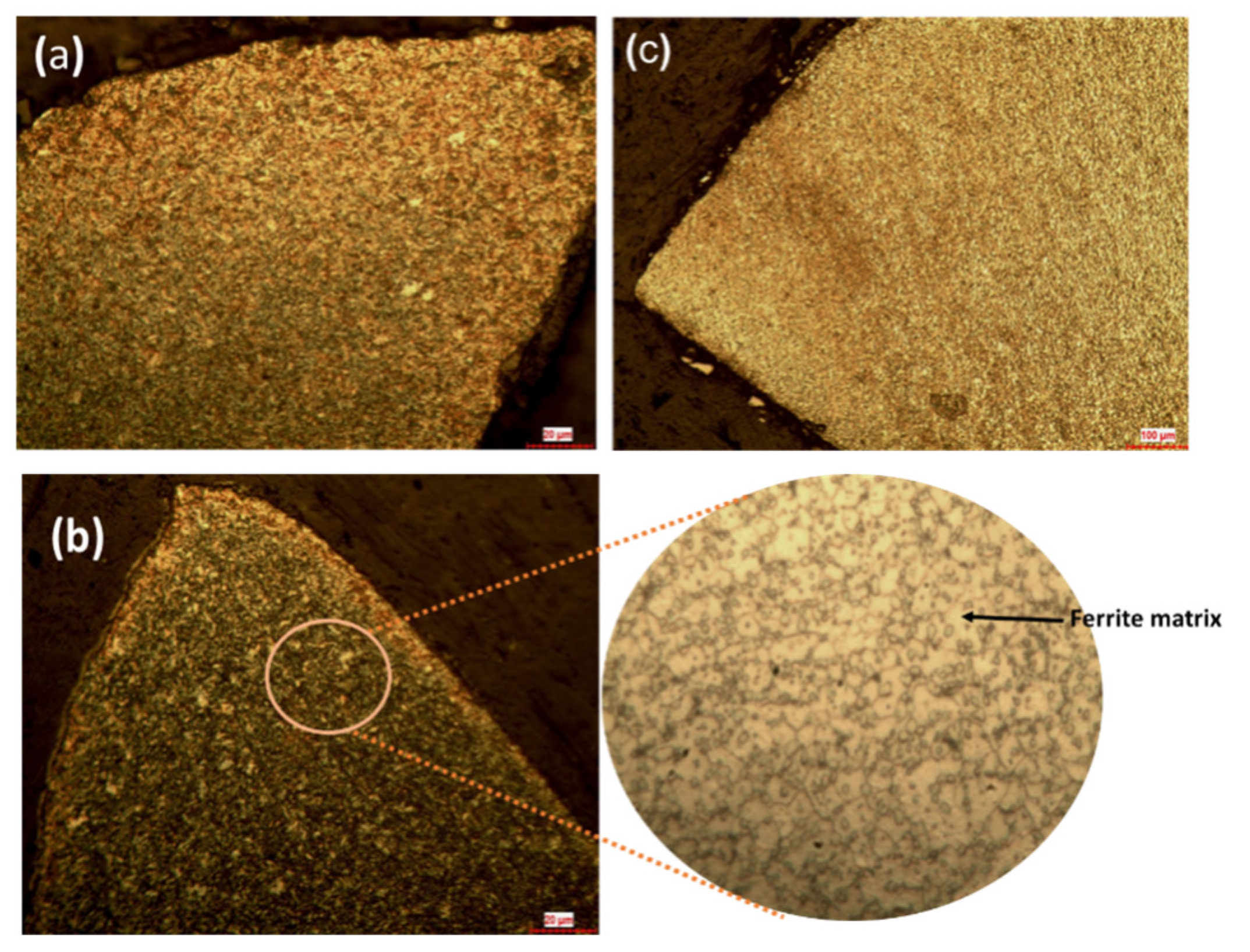
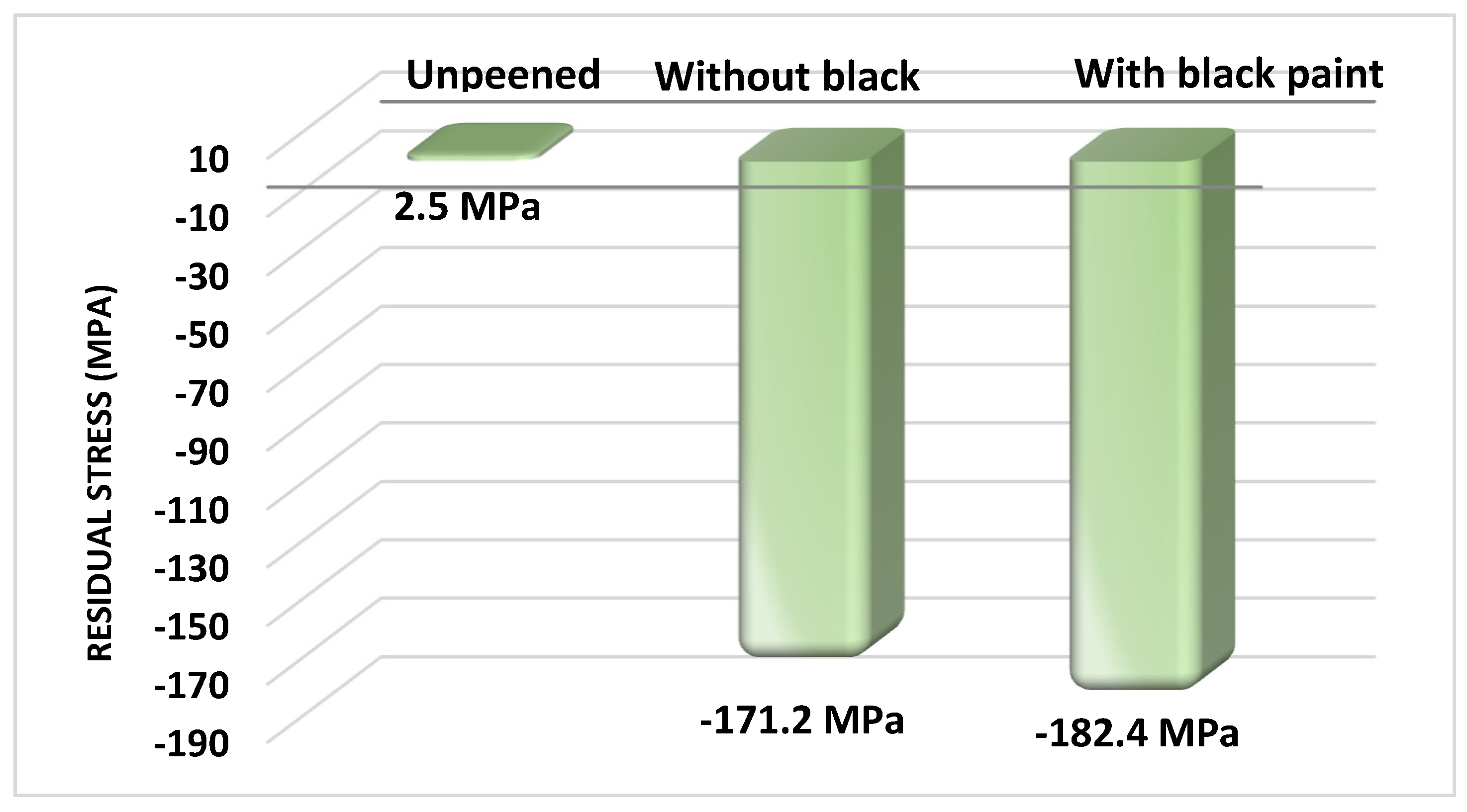
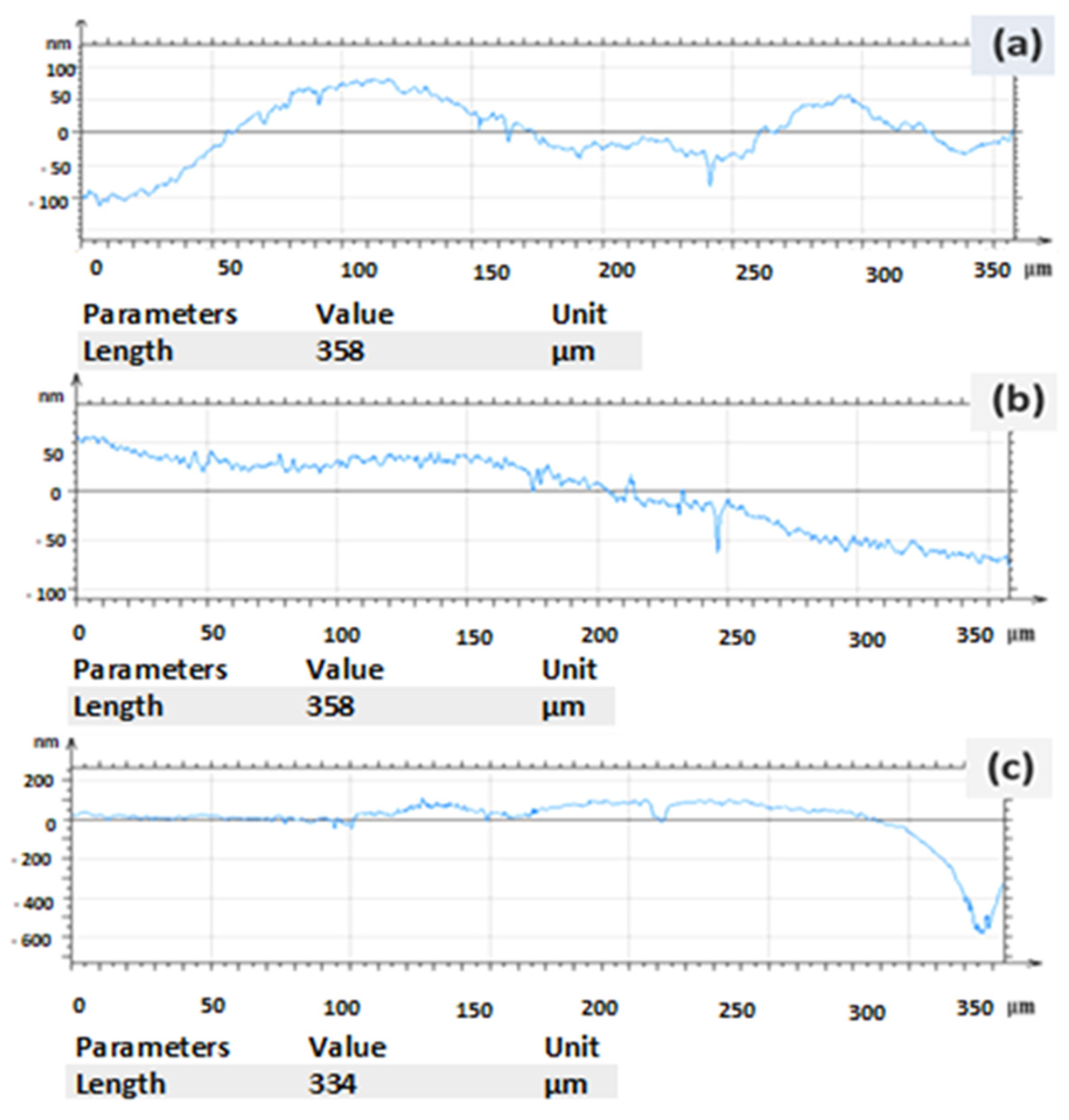
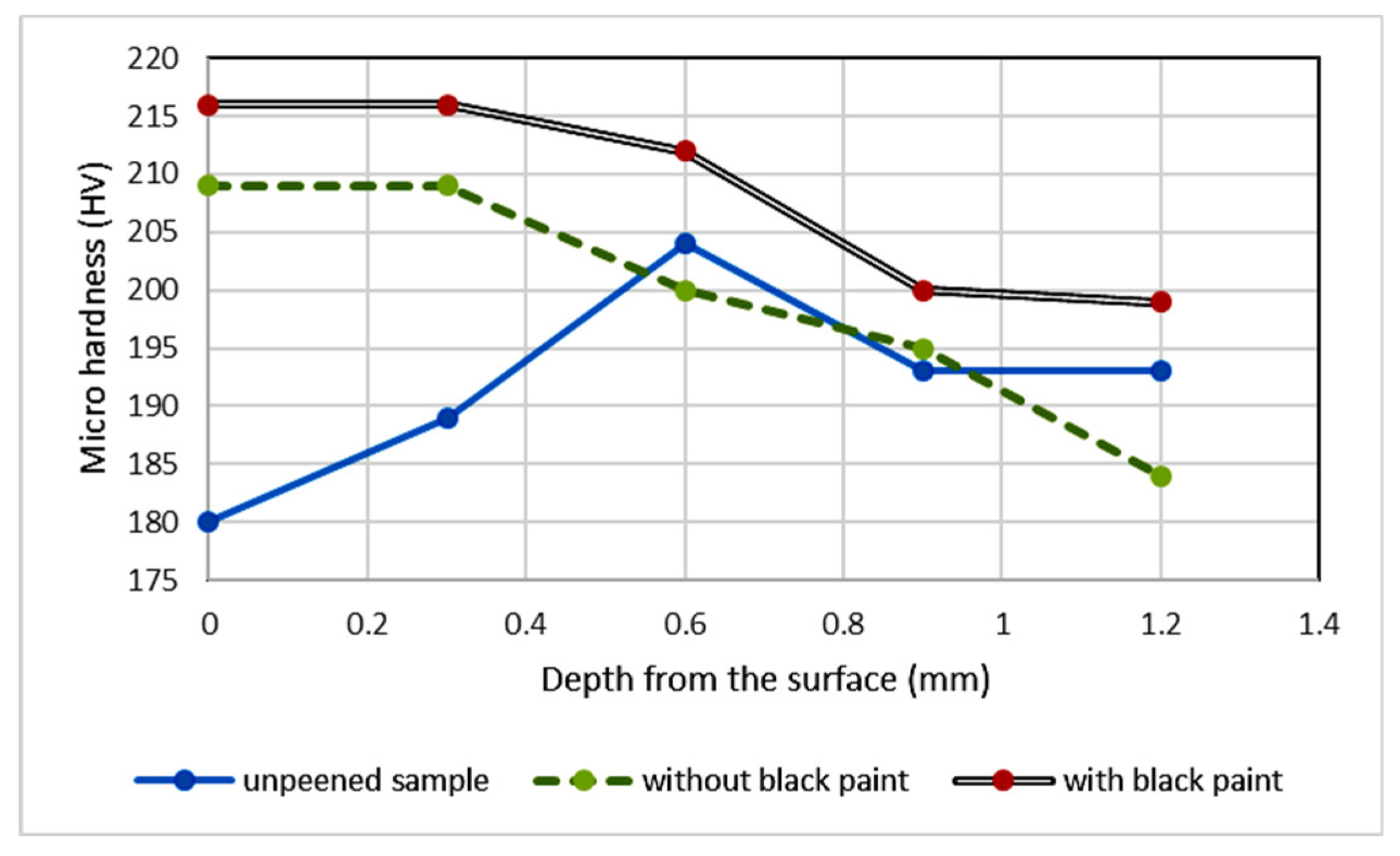
| Composition | C | Mn | Si | S | P |
|---|---|---|---|---|---|
| Percentage (wt.%) | 0.64 | 0.77 | 0.205 | 0.90 | 0.035 |
| Density (g/m3) | Modulus of Elasticity (GPa) | Poisson’s Ratio | Ultimate Tensile Strength (MPa) | Tensile Yield Strength (MPa) | Elongation (%) |
|---|---|---|---|---|---|
| 7.85 | 200 | 0.27 | 635 | 490 | 18 |
| Si. No | Unpeened | Laser-Shock-Peened with Paint | Laser-Shock-Peened without Paint |
|---|---|---|---|
| 1 | 1.241 | 2.487 | 3.025 |
| 2 | 1.033 | 2.612 | 3.841 |
| 3 | 1.257 | 2.533 | 3.516 |
| Average | 1.177 | 2.544 | 3.46 |
Disclaimer/Publisher’s Note: The statements, opinions and data contained in all publications are solely those of the individual author(s) and contributor(s) and not of MDPI and/or the editor(s). MDPI and/or the editor(s) disclaim responsibility for any injury to people or property resulting from any ideas, methods, instructions or products referred to in the content. |
© 2023 by the authors. Licensee MDPI, Basel, Switzerland. This article is an open access article distributed under the terms and conditions of the Creative Commons Attribution (CC BY) license (https://creativecommons.org/licenses/by/4.0/).
Share and Cite
Dhakshinamoorthy, P.; Harihara Subramanian, K.; Kannan, K.; Palani, G. Study of Surface Modifications of Textile Card Clothing (AISI 1065 Alloy) by Laser Shock Peening. Materials 2023, 16, 3944. https://doi.org/10.3390/ma16113944
Dhakshinamoorthy P, Harihara Subramanian K, Kannan K, Palani G. Study of Surface Modifications of Textile Card Clothing (AISI 1065 Alloy) by Laser Shock Peening. Materials. 2023; 16(11):3944. https://doi.org/10.3390/ma16113944
Chicago/Turabian StyleDhakshinamoorthy, Praveena, Krishnan Harihara Subramanian, Karthik Kannan, and Geetha Palani. 2023. "Study of Surface Modifications of Textile Card Clothing (AISI 1065 Alloy) by Laser Shock Peening" Materials 16, no. 11: 3944. https://doi.org/10.3390/ma16113944
APA StyleDhakshinamoorthy, P., Harihara Subramanian, K., Kannan, K., & Palani, G. (2023). Study of Surface Modifications of Textile Card Clothing (AISI 1065 Alloy) by Laser Shock Peening. Materials, 16(11), 3944. https://doi.org/10.3390/ma16113944







